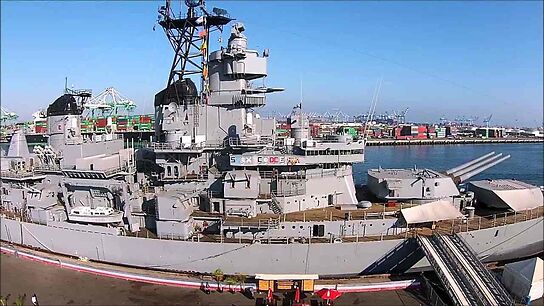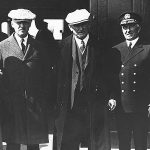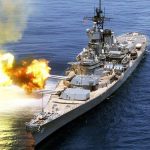During the Second World War, San Pedro was used as a naval base by the US Navy. No longer host to the proud battleships of the Pacific Fleet, reports that the USS Iowa may end up permanently in San Pedro as a museum ship have been met with enthusiasm by many residents. Iowa was built during WWII
Battleships as Museum Ships
Few naval architects in the 1930s and 1940s could have predicted that ships built according to their designs would end up being preserved as historic relics. But for the architects and designers who worked on battleships constructed before and during the Second World War, the ultimate fate of many of their projects has been that of the floating museum rather than the cutting torches of a scrapyard.
For the Iowa Class, the last class of battleships built by the United States Navy, service as museum ships has generally marked the end of their long careers. USS Missouri is berthed in Pearl Harbor, USS Wisconsin in Norfolk, and USS New Jersey in Camden. The only exception is the class leader, USS Iowa, which currently resides with the mothballed vessels of the US Naval Reserve Fleet in Suisun Bay, California. However, as of 2011 the Iowa appears to be slated to join her sisters as a museum ship. For years there has been a movement to place a battleship in San Pedro, California, and in late 2011 it looked to be a done deal. USS Iowa would end her career in the California port that served as the home base for the US Pacific Fleet immediately prior to its move to Pearl Harbor in Hawaii.
This fate for Iowa has long been in doubt, however. A powerful explosion in one of her massive gun turrets killed nearly fifty sailors and left her permanently scarred; it was judged too expensive to repair her considering her age. Only kept out of the scrapyard due to congressional intervention, USS Iowa and her less well-kept sisters faced an unknown fate through much of the 1990s as the end of the Cold War made the likelihood of their massive 16″ guns being needed by the modern navy declined.
USS Iowa: Leader of Her Class
The Iowa Class battleships were designed as World War II threatened and the need for vessels that could keep up with the US Navy’s fast aircraft carriers was recognized by naval planners. They carried nine 16″ naval guns in three triple turrets arranged two forward, one aft along the centerline of the ship, and up to twenty 5″ dual purpose (anti-aircraft or anti-surface target) guns scattered in ten twin turrets on the port and starboard side of the superstructure. Anti-aircraft armament was augmented by upwards of eighty 40mm and fifty 20mm anti-aircraft guns, which was a huge increase over the designs of a mere ten years earlier and reflected the threat to surface ships posed by naval and land based aircraft during World War II.
Their top speed was around 33 knots, and they displaced a good 45,000 tons. Almost 900 feet long and over 100 feet wide, the Iowas needed nearly 40 feet of water under the keel to avoid grounding. They were crewed by nearly 3000 officers and enlisted, and were some of the largest warships built by the United States until the navy began to deploy the powerful supercarriers of the Forrestal class during the late 1950’s. Interestingly enough, considering their cost, they were not extremely well armored. Unlike many contemporary battleships the USS Iowa and her sister ships could not protect themselves from battleships armed with guns of equivalent size to theirs.
As a comparison, the KMS Tirpitz of the German navy was the sister of the KMS Bismarck and sported main armor belt thickness that was nearly an inch thicker than that on the Iowa even though she was several thousand tons and a few years older. Although Iowa’s decks and turrets were more heavily armored this effectively meant that she was more vulnerable to incoming shells hitting on a flatter trajectory than was the Tirpitz – and at the maximum range of a naval gun, the trajectory is at its flattest. If the two had ever met, Iowa would have to have been handled carefully to avoid damage – her slightly higher speed and better plunging fire protection in conjunction with her slightly heavier broadside would have meant that she likely needed to close range with Tirpitz quickly and try to knock out her opponent’s less well armored turrets before they could deal significant damage to the Iowa’s structure and crew.
The Long History of the Iowa
USS Iowa began her career in 1943 and served as President Franklin D. Roosevelt’s transportation to the Tehran Conference where the Western Allies and Soviet Union agreed to force an unconditional surrender on the part of Germany, and completely destroy the German government and state as it currently existed. She was also held in reserve against the threat posed by the Tirpitz, which at the time was stationed in Norway as a fleet-in-being and a potential threat to Allied convoys bound for the Soviet port of Murmansk.
But the danger posed by Tirpitz and other German surface ships waned as the war turned against the Axis, and Iowa was soon transferred to the Pacific. There she fulfilled her role as a fast, heavy escort to US aircraft carriers, and used her powerful anti-aircraft armament to screen these and other ships from Japanese air attack. In addition she was used as a bombardment platform attacking shore based targets of tactical and strategic importance, as well as a blocking ship to help keep Japanese vessels from escaping to the open sea. In this role she helped sink a Japanese cruiser and shot down numerous aircraft, and bombarded targets from the central Pacific and the Philippines to the Japanese Home Islands themselves. She was present in Tokyo Bay during the Japanese surrender that ended World War II, and her sister ship, the USS Missouri, was the site of that historic event that ended the bloodiest conflict in history.
Iowa also served with distinction in Korea, shelling North Korean targets in support of the US and UN forces that were locked in a bloody stalemate along the Korean peninsula. She was also used in flag showing operations in the Mediterranean and in NATO exercises in the North Atlantic before being deactivated and sent to the reserves in the 1950s.
There she and her sisters languished for over 20 years, until a US naval buildup in the 1980s led to their reactivation and intensive modernization. There most of the old style anti-aircraft armament was removed and replaced with Phalanx point defense gatlings, Harpoon anti-ship missiles, and Tomahawk cruise missiles. The latter were fired by Missouri and Wisconsin against Iraq in the 1991 Gulf War, and their massive 16″ guns opened up on Iraqi positions near to the Persian Gulf as part of a deception meant to convince Iraq that a Marine landing on its short coast was in the works.
Retirement of the USS Iowa and Donation As a Museum Ship
Iowa was one of the first of her sisters to be decommissioned due to a terrible explosion in her number two turret that killed forty-seven US sailors and was the subject of a highly suspect investigation by the US Navy. This controversial episode featured officers with a personal interest in the outcome of the investigation proceeding to accuse a deceased member of the turret crew of sabotage. A later, independent investigation concluded that the more likely cause of the disaster was a mechanical defect coupled with an overfill of explosive powder that caused a catastrophic detonation in the gun barrel.
The end result of the accident was the deactivation of Iowa only a few years after her modernization, and her relegation to the Suisun Bay Naval Reserve Fleet. It was judged to be too expensive to fix her turret, and the Navy had come to the conclusion that the Iowas had come to the end of their useful lives. Their crews were too large and their armament too weak to be particularly effective in a modern threat environment – the new Aegis class cruisers could carry three times as many cruise missiles at a fraction of the cost. Although Congress intervened to order that at least two Iowas be kept in perpetual readiness to be reactivated in case their heavy gun armament was ever needed, the future of the Iowas looked bleak.
Since the 1990’s, one after another the Iowas have been donated as museum ships – all save for Iowa. But that appears likely to change. An effort to put a battleship in San Pedro, California is near to success, with final impact assessments underway as of 2011. As a museum ship, Iowa would bring needed revenue to San Pedro and bring the port, not far from Los Angeles proper, a reminder of its history as a battleship base.
Once moved from Suisun Bay (near San Francisco) the Iowa will become the fourth of her sisters to serve as a museum ship.
USS Iowa: To Become Museum Battleship in San Pedro







Comments are closed